-
ORIGINAL ARTICLE07-29-2024
Evidence of validity of the Risk Self-Medication Questionnaire focused on Health Literacy
Revista Brasileira de Enfermagem. 2024;77(3):e20230386
Abstract
ORIGINAL ARTICLEEvidence of validity of the Risk Self-Medication Questionnaire focused on Health Literacy
Revista Brasileira de Enfermagem. 2024;77(3):e20230386
DOI 10.1590/0034-7167-2023-0386
Views0See moreABSTRACT
Objectives:
to analyze the validity evidence of the internal structure of the Risk Self-Medication Questionnaire Focused on Health Literacy.
Methods:
a psychometric study with 499 adults. The internal structure was assessed with exploratory and confirmatory factor analysis to prove the adjustment. Internal consistency was measured by composite reliability and McDonald’s omega coefficient (ω).
Results:
the parameters revealed a model of 35 items distributed across four factors, explaining 56% of the total variance, with factor loadings ranging from 0.31 to 0.85 and adequate communalities. Accuracy (0.79
Conclusions:
an instrument was obtained with good evidence of structural validity for measuring self-medication.
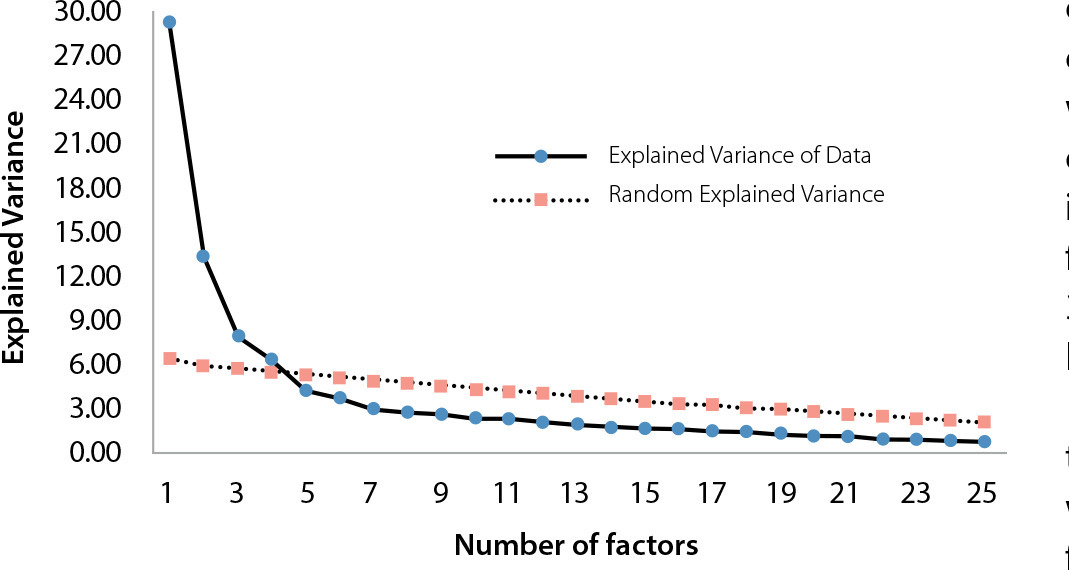
-
ORIGINAL ARTICLE07-29-2024
Nurses’ perspectives on nurses’ work methods
Revista Brasileira de Enfermagem. 2024;77(3):e20230374
Abstract
ORIGINAL ARTICLENurses’ perspectives on nurses’ work methods
Revista Brasileira de Enfermagem. 2024;77(3):e20230374
DOI 10.1590/0034-7167-2023-0374
Views0See moreABSTRACT
Objectives:
To analyze nurses’ perspectives on nurses’ work methods in the hospital context.
Methods:
A descriptive study with a qualitative approach was conducted in a hospital in northern Portugal, involving 17 nurses. Semi-structured interviews were used for data collection. Data collected between May and June 2023 underwent content analysis, supported by Atlas.ti software.
Results:
Three thematic areas emerged: “Nurses’ work methods in a hospital context,” highlighting the conception and components of work methods and the methods in use; “Implementation of nurses’ work methods,” emphasizing influencing factors and challenges to implementation; and “Impact of nurses’ work methods on patients, nurses, and institutions.”
Final Considerations:
Nurses’ work methods constitute the structure of nursing care. Some factors influence and some challenges arise in the implementation of these methods, producing impacts on patients, nurses, and institutions.

-
ORIGINAL ARTICLE07-29-2024
Nursing Process for institutionalized older adults: contributions from knowledge awareness workshop
Revista Brasileira de Enfermagem. 2024;77(3):e20230349
Abstract
ORIGINAL ARTICLENursing Process for institutionalized older adults: contributions from knowledge awareness workshop
Revista Brasileira de Enfermagem. 2024;77(3):e20230349
DOI 10.1590/0034-7167-2023-0349
Views0See moreABSTRACT
Objective:
To analyze the knowledge of professionals working in a Nursing Home about the Nursing Process before and after the awareness workshop.
Methods:
This is strategic action research, developed with nursing professionals and managers of a Nursing Home in Rio Grande do Sul, Brazil. Data were collected between January and June 2023, through semi-structured interviews before and after an awareness workshop. Discursive textual analysis of the data was carried out.
Results:
The central category “Understanding about the Nursing Process in Nursing Homes” emerged, which was unitized into two units of meaning and three categories of analysis.
Conclusion:
Data revealed non-use and lack of knowledge of the Nursing Process before awareness raising. Afterwards, a deeper understanding of the topic and its importance was identified. Awareness-raising workshops contribute to transformation of knowledge.
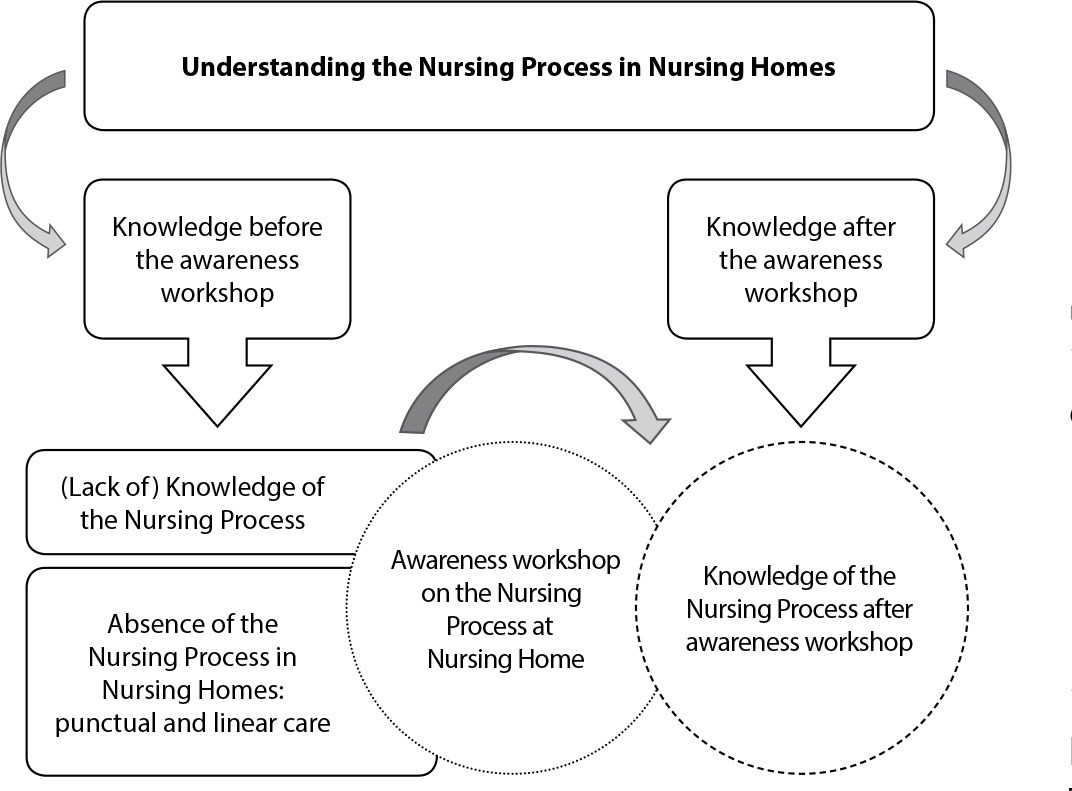
-
ORIGINAL ARTICLE07-29-2024
Excessive daytime sleepiness in nursing technicians: association with sleep quality and memory
Revista Brasileira de Enfermagem. 2024;77(3):e20230332
Abstract
ORIGINAL ARTICLEExcessive daytime sleepiness in nursing technicians: association with sleep quality and memory
Revista Brasileira de Enfermagem. 2024;77(3):e20230332
DOI 10.1590/0034-7167-2023-0332
Views0See moreABSTRACT
Objective:
to investigate excessive daytime sleepiness prevalence among nursing technicians and the association with sleep quality and memory.
Methods:
a cross-sectional, inferential study, carried out in a hospital unit in the state of Goiás between December 2020 and January 2021. Assessments were carried out using the Epworth Sleepiness Scale, the Pittsburgh Sleep Quality Index and the Prospective and Retrospective Memory Questionnaire, instruments validated for the Brazilian context. Bivariate and multivariate logistic regression analyzes were performed.
Results:
the sample consisted of 189 nursing technicians with a 40.9% excessive daytime sleepiness prevalence. In multivariate models, excessive daytime sleepiness was not associated with sleep quality, however there was a significant association with overall memory failures.
Conclusions:
study results demonstrate a high excessive daytime sleepiness occurrence, an association with overall memory failures and the need for psychosocial interventions for nursing technicians.
-
ORIGINAL ARTICLE07-29-2024
Educational technology for multidisciplinary training for managing waiting lists for elective patients
Revista Brasileira de Enfermagem. 2024;77(3):e20230299
Abstract
ORIGINAL ARTICLEEducational technology for multidisciplinary training for managing waiting lists for elective patients
Revista Brasileira de Enfermagem. 2024;77(3):e20230299
DOI 10.1590/0034-7167-2023-0299
Views1See moreABSTRACT
Objectives:
to construct and assess an educational technology for managing patient waiting lists for multidisciplinary training.
Methods:
study supported by Instructional Design – ADDIE model, whose stages of construction of educational technology were developed in the form of a multi-professional training course. Its respective content assessment was carried out by a committee of experts from 2021 to 2022. The analysis occurred based on the proportion of content adequacy with 95% Confidence Interval.
Results:
seventeen products were created as educational technology learning objects: five storyboards; four videos; three comic books; two pedagogical action plans; a mind map; and a YouTube® playlist. Nine experts assessed content adequacy, which reached 0.89.
Conclusions:
this educational technology contributes to the performance of professionals who manage waiting lists by reducing inequalities, alleviating differences, in addition to promoting equity in care and good health for patients in the Brazilian Health System.
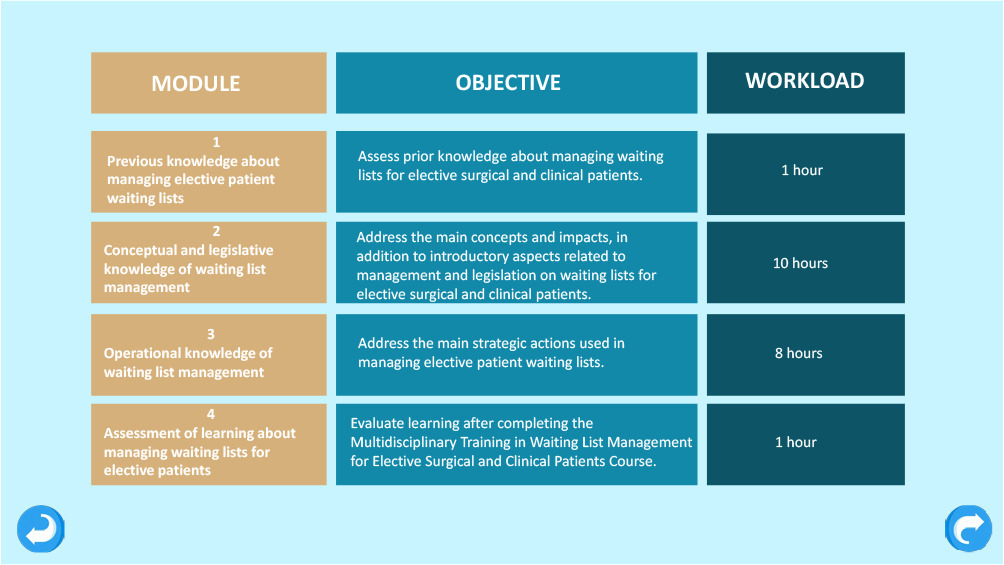
-
ORIGINAL ARTICLE07-29-2024
Fuzzy Logic: vulnerability of women who have sex with women to sexually transmitted infections
Revista Brasileira de Enfermagem. 2024;77(3):e20230271
Abstract
ORIGINAL ARTICLEFuzzy Logic: vulnerability of women who have sex with women to sexually transmitted infections
Revista Brasileira de Enfermagem. 2024;77(3):e20230271
DOI 10.1590/0034-7167-2023-0271
Views0ABSTRACT
Objective:
To describe the possibility of applying Fuzzy Logic in analyzing the vulnerability of Women Who Have Sex with Women to Sexually Transmitted Infections/HIV/AIDS.
Methods:
We developed a Fuzzy Logic system with 17 input variables and one output variable, using data related to vulnerability in a municipality located in the Midwest region of the State of São Paulo, Brazil.
Results:
The factor with the greatest positive impact was the confirmation that a low understanding of Sexually Transmitted Infections/HIV/AIDS is associated with higher vulnerability. Conversely, the statement “Not disclosing sexual activity to healthcare professionals,” where individuals do not admit to having sex with women, had the least impact.
Conclusions:
Fuzzy Logic facilitates the identification of vulnerability, expressed through the analysis of interaction between variables in each dimension. This makes it a promising method to assist in analyzing the vulnerability of specific populations.
Keywords:Fuzzy LogicHealth VulnerabilityReproductive HealthSexually Transmitted DiseasesWomen Who Have Sex With WomenSee more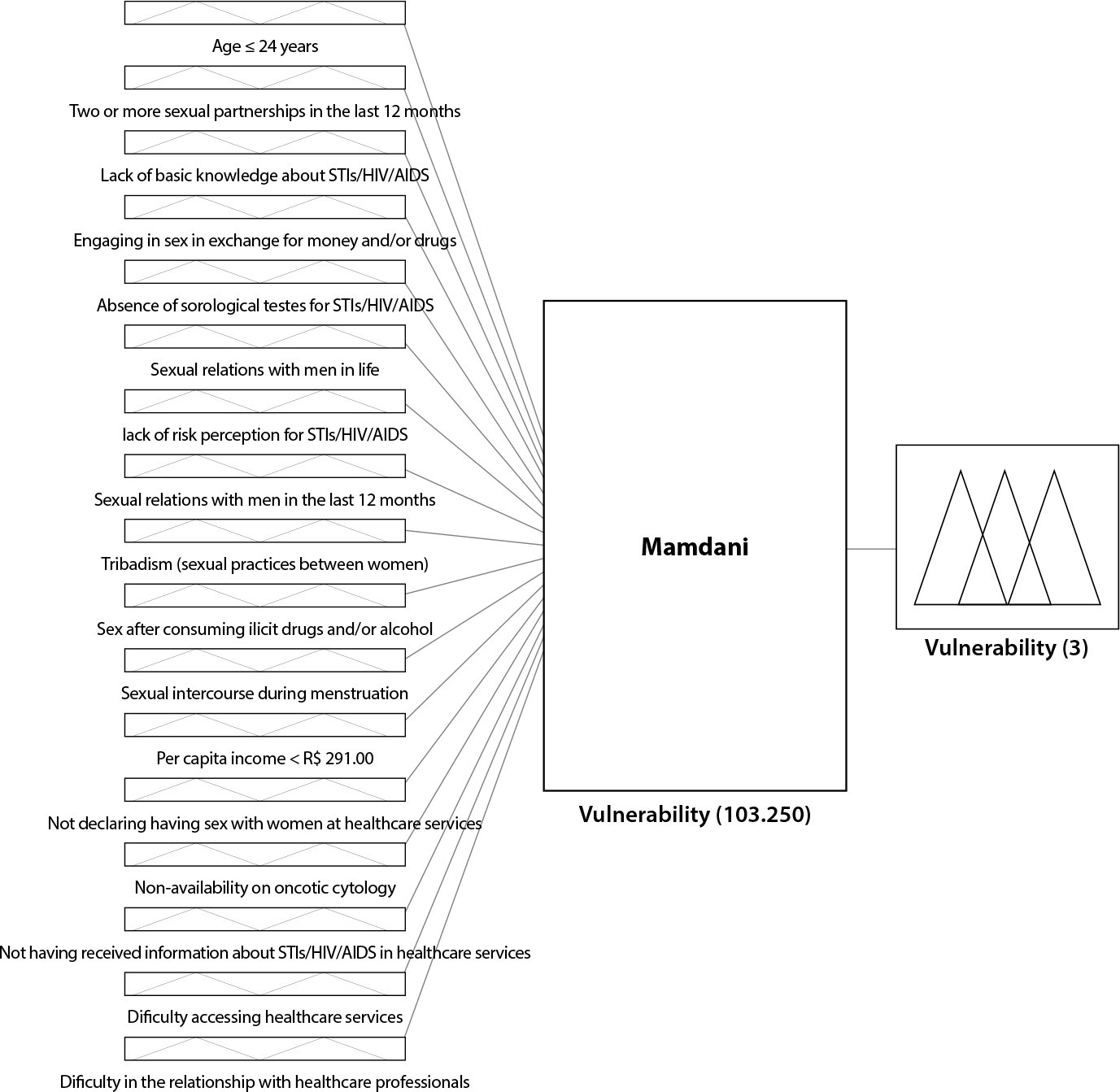
-
ORIGINAL ARTICLE07-29-2024
University Student Depression Inventory, Brazilian Version, Construct Assessment
Revista Brasileira de Enfermagem. 2024;77(3):e20230232
Abstract
ORIGINAL ARTICLEUniversity Student Depression Inventory, Brazilian Version, Construct Assessment
Revista Brasileira de Enfermagem. 2024;77(3):e20230232
DOI 10.1590/0034-7167-2023-0232
Views0See moreABSTRACT
Objectives:
to assess the University Student Depression Inventory, Brazilian version (USDI-BR), construct.
Methods:
a methodological study carried out with a snowball probabilistic sample, consisting of 334 undergraduate and graduate students. Confirmatory factor analysis, reliability using McDonald’s omega coefficient and Cronbach’s alpha were performed. Principal component analysis was performed using the varimax rotation and oblimin rotation, using the Kaiser-Meyer-Olkin criteria, Bartlett’s test of sphericity and scree plot.
Results:
the USDI-BR presented an internal consistency of items of ω = 0.95 and remained with 30 items, with the addition of 1 factor (Death wish and social withdrawal), totaling 4 factors.
Conclusions:
the USDI-BR has evidence that points to its validity and also its internal consistency, deserving that new studies be carried out to expand the evidence of its psychometric properties.
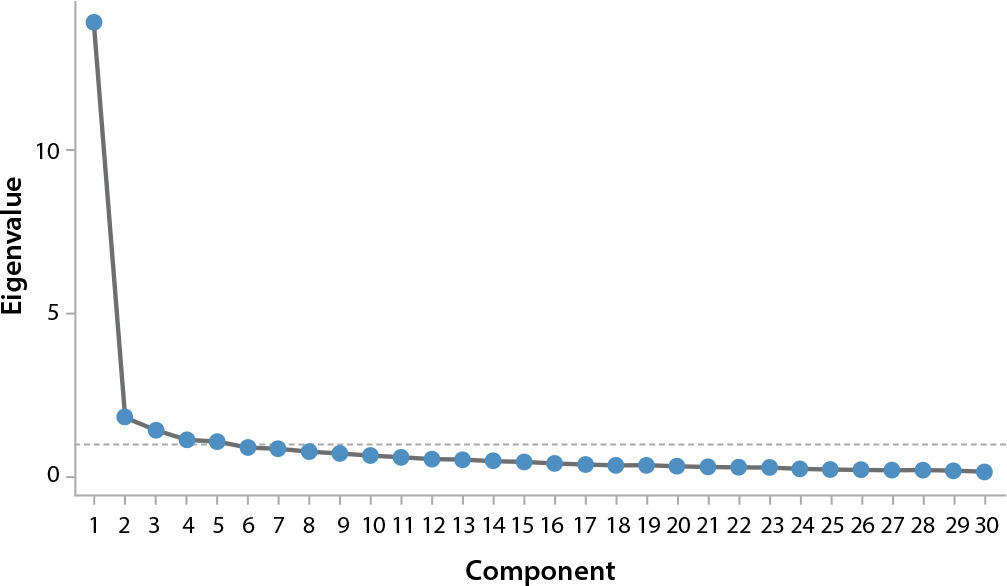
-
ORIGINAL ARTICLE07-29-2024
Family refusal of skin donation for transplantation: trends and associated factors
Revista Brasileira de Enfermagem. 2024;77(3):e20230209
Abstract
ORIGINAL ARTICLEFamily refusal of skin donation for transplantation: trends and associated factors
Revista Brasileira de Enfermagem. 2024;77(3):e20230209
DOI 10.1590/0034-7167-2023-0209
Views0See moreABSTRACT
Objectives:
to analyze the trends and factors associated with family refusal of skin donation for transplantation.
Methods:
this cross-sectional study was conducted in the State of São Paulo, with family authorization terms collected from 2001 to 2020. The variables analyzed included year, age, gender, cause of death, and type of institution. Data were analyzed using linear and multiple logistic regression, with the Odds Ratio estimated at p<0.05 for statistical significance.
Results:
1,355 individuals refused skin donation. The trend of refusals decreased between 2001 and 2009 in the age groups of 0-11 years and 12-19 years, but increased in the group aged ≥60 years. This trend continued to decrease in the 0-11 years group from 2010 to 2020, and increased in the 20-40 years group. Males and the age groups of 20-40 years, 41-59 years, and ≥60 years exhibited 27%, 34%, 47%, and 53% lower chances of refusal, respectively.
Conclusions:
there is an urgent need for measures to mitigate the high number of refusals associated with skin donation.
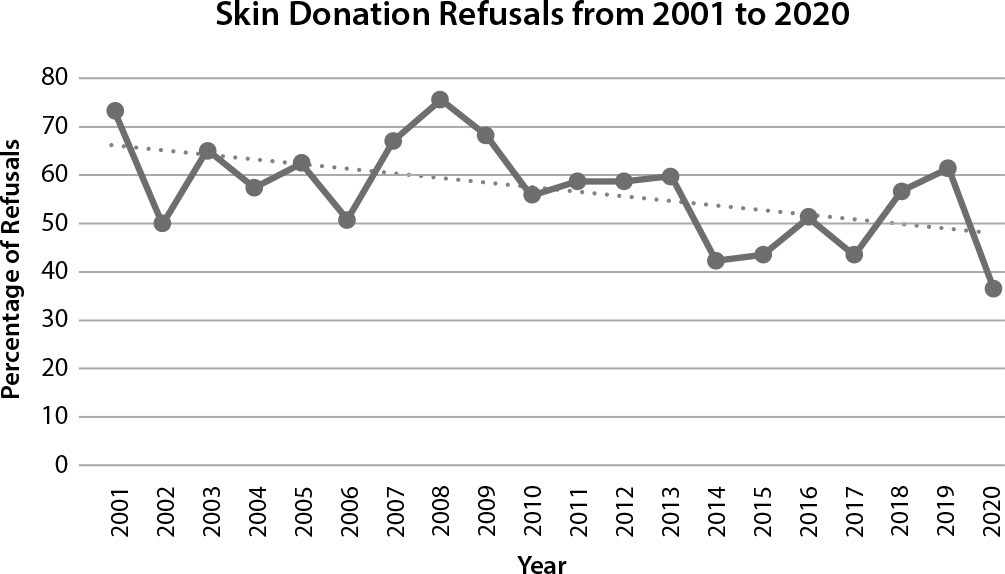
-
RESEARCH06-01-2015
Workers of CEASA: factors associated with fatigue and work ability
Revista Brasileira de Enfermagem. 2015;68(3):460-466
Abstract
RESEARCHWorkers of CEASA: factors associated with fatigue and work ability
Revista Brasileira de Enfermagem. 2015;68(3):460-466
DOI 10.1590/0034-7167.2015680312i
Views0See moreABSTRACT
Objective:
to investigate the socio-demographic characteristics, lifestyle and health conditions related to fatigue and the work ability.
Method:
a cross-sectional study was conducted in 2011 and the sample was composed by 90 workers from the supply center of Campinas. Three questionnaires were used: Fatigue; Work ability index; and socio-demographic characteristics.
Results:
in the univariate regression analysis, the variables associated with work ability were: education, use of medicine, stress, pain in the last six months and pain in the last week. In univariate regression analysis the variables associated with fatigue were: education, stress, sleepiness, pain in the last six months, pain in the last week and health problems.
Conclusion:
these results indicate the need for health promotion program implementation among these workers.
-
RESEARCH06-01-2015
Nursing Terminology defines domestic violence against children and adolescents
Revista Brasileira de Enfermagem. 2015;68(3):452-459
Abstract
RESEARCHNursing Terminology defines domestic violence against children and adolescents
Revista Brasileira de Enfermagem. 2015;68(3):452-459
DOI 10.1590/0034-7167.2015680311i
Views0See moreABSTRACT
Objective:
Identifi cation of terminology relating to nursing practices aimed at children and adolescents at risk of domestic violence.
Methods:
bibliographic descriptive research which selected 40 articles from the Virtual Health Library on domestic violence against children and adolescents, its manifestations, causes, and consequences, in association with nursing procedures for its confrontation and prevention, and which also identifi ed terminology via computer tools.
Results:
17,365 terms that, after standardization and uniformity procedures, resulted in a listing of 915 terms.
Conclusion:
The terminology selected focused on the individual biopsychic nexus and the historic manifestation of this phenomenon was partially identifi ed in terms that appear less frequently in these articles, thereby explaining the contradiction between the formal identifi cation logic of such terminology and the dialectic logic that recognizes the historic reasons for, and dynamicity of, such phenomena.
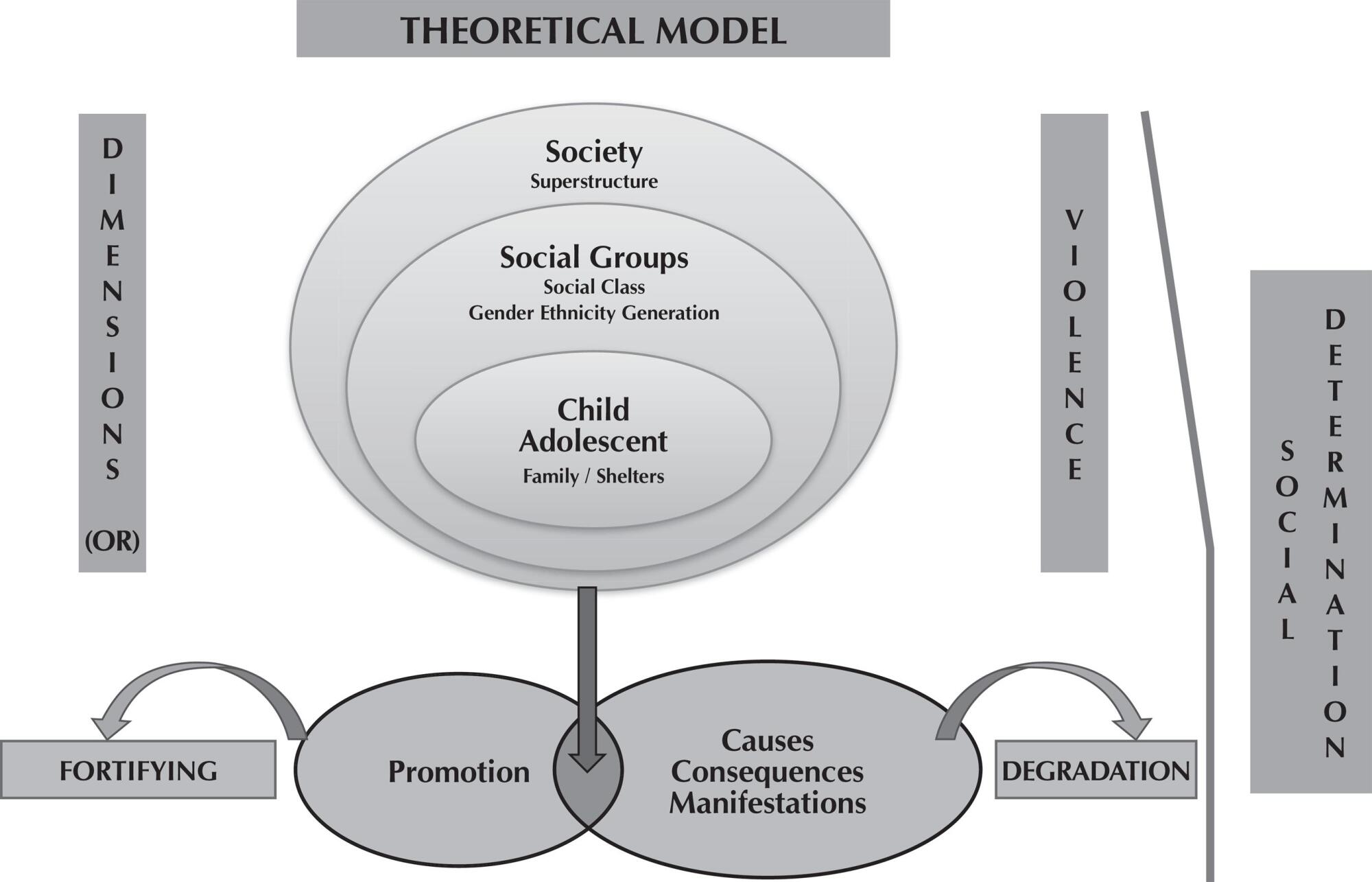
-
RESEARCH06-01-2015
Instrumento para avaliação de estilo de vida sedentário em pacientes com hipertensão
Revista Brasileira de Enfermagem. 2015;68(3):445-451
Abstract
RESEARCHInstrumento para avaliação de estilo de vida sedentário em pacientes com hipertensão
Revista Brasileira de Enfermagem. 2015;68(3):445-451
DOI 10.1590/0034-7167.2015680310i
Views0See moreRESUMEN
Objetivo:
este artículo describe la precisión diagnóstica del International Physical Activity Questionnaire en la identifi cación del diagnóstico enfermero Estilo de vida sedentario.
Método:
un estudio de precisión diagnóstica se desarrolló con 240 individuos con hipertensión arterial establecida. El análisis de precisión diagnóstica se basó en medidas de sensibilidad, especifi cidad, valores predictivos, razones de verosimilitud, efi ciencia, odds ratio diagnóstica, índice de Youden y área bajo la curva característica receptor-operador.
Resultados:
diferencias estadísticas entre los sexos se observaron para las actividades intensidad moderada y la actividad física total. La edad se correlacionó negativamente con la actividad de intensidad moderada y la actividad física total.
Conclusión:
el análisis del área bajo la curva característica receptor-operador para las actividades de intensidad moderada, de caminar, y la actividad física total mostró que el International Physical Activity Questionnaire presenta moderada capacidad para clasificar correctamente los sujetos con y sin el estilo de vida sedentario.
-
RESEARCH06-01-2015
Instrument for evaluation of sedentary lifestyle in patients with high blood pressure
Revista Brasileira de Enfermagem. 2015;68(3):445-451
Abstract
RESEARCHInstrument for evaluation of sedentary lifestyle in patients with high blood pressure
Revista Brasileira de Enfermagem. 2015;68(3):445-451
DOI 10.1590/0034-7167.2015680310i
Views0See moreABSTRACT
Objective:
this article describes the diagnostic accuracy of the International Physical Activity Questionnaire to identify the nursing diagnosis of sedentary lifestyle.
Method:
a diagnostic accuracy study was developed with 240 individuals with established high blood pressure. The analysis of diagnostic accuracy was based on measures of sensitivity, specifi city, predictive values, likelihood ratios, effi ciency, diagnostic odds ratio, Youden index, and area under the receiver-operating characteristic curve.
Results:
statistical differences between genders were observed for activities of moderate intensity and for total physical activity. Age was negatively correlated with activities of moderate intensity and total physical activity.
Conclusion:
the analysis of area under the receiver-operating characteristic curve for moderate intensity activities, walking, and total physical activity showed that the International Physical Activity Questionnaire present moderate capacity to correctly classify individuals with and without sedentary lifestyle.
-
RESEARCH06-01-2015
Potentialities and weaknesses in the care network of people with HIV/AIDS
Revista Brasileira de Enfermagem. 2015;68(3):438-444
Abstract
RESEARCHPotentialities and weaknesses in the care network of people with HIV/AIDS
Revista Brasileira de Enfermagem. 2015;68(3):438-444
DOI 10.1590/0034-7167.2015680309i
Views0See moreABSTRACT
Objective:
to understand the strengths and weaknesses in the care network of people with HIV/AIDS in a referral center in the state of Santa Catarina-SC.
Method:
participants were eight subjects and their care network, totaling 18 participants. Data were collected through interviews and examined by content analysis, theoretically supported by symbolic interaction.
Results:
the analysis resulted in the following categories: The network offering care to people with acquired immunodefi ciency syndrome, and Facing Barriers in care, which refl ect the strengths and weaknesses in the care network. The fi rst depicts the provision of emotional and humanized care, and the second a restricted network formed by health professionals and a family member.
Conclusion:
the professional care network is important, despite the increased number of assistances in a physical structure and amount of professionals who no longer meet the growing demand.
-
RESEARCH06-01-2015
AIDS epidemic in the triple frontier: subsidies for professional practice
Revista Brasileira de Enfermagem. 2015;68(3):429-437
Abstract
RESEARCHAIDS epidemic in the triple frontier: subsidies for professional practice
Revista Brasileira de Enfermagem. 2015;68(3):429-437
DOI 10.1590/0034-7167.2015680308i
Views0See moreABSTRACT
Objective:
to analyze the AIDS epidemic trend from 1988 to 2012, in a tri-border area.
Method:
Ecological time-series study with data from the Department of informatics from the Brazilian Unifi ed Health System (SUS).
Results:
A total of 1427 cases of AIDS were registered, and 82.1% were aged 20-49 years and 56% in males. The relationship man/woman went from 9/1 to 1/1 and increased the number of cases among individuals with more years of education, also, people aged more than 50 years old the age group from 20 to 34 years old. The most common exposure category was heterosexual, significantly higher among women; on the other hand, drug injection use was associated with male gender.
Conclusion:
seeking to embrace the changes in the epidemiological scenario of AIDS, nursing professionals should implement intervention strategies for people identified as the most vulnerable to HIV infection.
-
RESEARCH06-01-2015
The Informal Caregiver Burden Assessment Questionnaire: validation for Brazil
Revista Brasileira de Enfermagem. 2015;68(3):421-428
Abstract
RESEARCHThe Informal Caregiver Burden Assessment Questionnaire: validation for Brazil
Revista Brasileira de Enfermagem. 2015;68(3):421-428
DOI 10.1590/0034-7167.2015680307i
Views0See moreABSTRACT
Objectives:
to analyze the dimensionality, convergent construct validity and internal consistency of the Informal Caregiver Burden Assessment Questionnaire (QASCI) after its semantic adaptation to Brazil.
Method:
this methodological study was developed with 132 informal caregivers of elders who are dependent of help for basic or instrumental activities of daily living, in a capital city in Northeast Brazil. Quality of life measures related to health, anxiety and depression were used in the analysis of the convergent construct validity of the QASCI.
Results:
the results of the instrument construct validation evidenced statistically signifi cant correlations with the three measures. The confi rmatory factor analysis evidenced good adjustment of the theoretical model of seven factors (domains) of the version used in the group studied. Cronbach’s alpha for the scale total was 0.92.
Conclusion:
the Brazilian version of the QASCI was considered to be valid and reliable for assessing the burden of informal elder caregivers.
-
RESEARCH06-01-2015
Study of billing audits in a teaching hospital
Revista Brasileira de Enfermagem. 2015;68(3):414-420
Abstract
RESEARCHStudy of billing audits in a teaching hospital
Revista Brasileira de Enfermagem. 2015;68(3):414-420
DOI 10.1590/0034-7167.2015680306i
Views0See moreABSTRACT
Objectives:
to determine which component items of hospital bills, examined by nurse auditors, were adjusted the most during pre-analysis; to identify the impact upon revenue caused by the adjustments to bills analyzed by physician and nurse auditors; and to identify disallowances related to items checked by the audit team.
Method:
quantitative, exploratory, descriptive, singlecase study.
Results:
after analysis of 2,613 bills, it was found that the item most included by nurses was gas (90.5%) and the most excluded was inpatient drugs (41.2%). Hemodynamics materials, gases and equipment had the greatest impact on upward adjustments. Downward adjustments were the result of improper entries on bills and did not generate revenue losses. Of total disallowances, 52.24% were related to the pre-analysis of nurses and 47.76% to that of physicians.
Conclusion:
this study of the pre-analysis process provides input that enhances knowledge about hospital bill audits.
-
ORIGINAL ARTICLE11-10-2023
Prenatal assessment of high-risk pregnancies in primary and specialized outpatient care: a mixed study
Revista Brasileira de Enfermagem. 2023;76(5):e20220420
Abstract
ORIGINAL ARTICLEPrenatal assessment of high-risk pregnancies in primary and specialized outpatient care: a mixed study
Revista Brasileira de Enfermagem. 2023;76(5):e20220420
DOI 10.1590/0034-7167-2022-0420
Views0ABSTRACT
Objectives:
to assess high-risk prenatal care and identify strategies for improving care.
Methods:
a mixed study of a prospective cohort, with 319 mothers in a public maternity hospital, from October 2016 to August 2017, using a semi-structured instrument and interview. Analysis was performed using the chi-square test (p≤0.05). The qualitative approach was carried out through interviews with guiding questions to 13 managers, at their workplace, between January and March 2020, analyzed under social phenomenology.
Results:
higher rates of inadequacy were identified for all criteria. However, when care was shared, there was a higher rate for performing tests (p=0.023), consultations (p=0.002), risk stratification (p=0.013) and emergency information (≤0.000). Weaknesses in the record evidenced impairment in communication and continuity of care.
Final Considerations:
shared care is a strategy for improving care, however there is a need to strengthen effective referral and counter-referral to care continuity.
Keywords:Health Services AdministrationPregnancy, High-RiskPrenatal CarePrimary Health CareSecondary CareSee more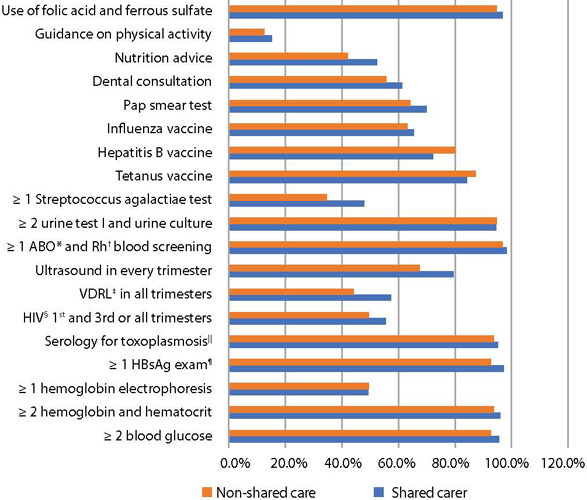
-
ERRATUM11-10-2023
ERRATUM
Revista Brasileira de Enfermagem. 2023;76(4):e2023n4e03
Abstract
ERRATUMERRATUM
Revista Brasileira de Enfermagem. 2023;76(4):e2023n4e03
DOI 10.1590/0034-7167.20237604e03
Views0In the article “Diabetic foot ulcer self-care assessment: a scoping review”, with DOI number: https://doi.org/10.1590/0034-7167-2022-0555, published in Revista Brasileira de Enfermagem, 2023;76(3): e20220555, in the title:Where it read:[…]See more -
ERRATUM10-30-2023
ERRATUM
Revista Brasileira de Enfermagem. 2023;76(3):e2023n3e01
Abstract
ERRATUMERRATUM
Revista Brasileira de Enfermagem. 2023;76(3):e2023n3e01
DOI 10.1590/0034-7167.20237603e01
Views0In the article “Perceptions of adults with obesity about multiprofessional remote monitoring at the beginning of the COVID-19 pandemic”, with DOI number: , published in Revista Brasileira de Enfermagem, 2021;74(Suppl 1): e20200710, on page 8:Where it read:[…]See more -
EDITORIAL10-09-2023
A pós-pandemia de COVID-19: perspectivas da atuação profissional na enfermagem
Revista Brasileira de Enfermagem. 2023;76:e76Suppl101
Abstract
EDITORIALA pós-pandemia de COVID-19: perspectivas da atuação profissional na enfermagem
Revista Brasileira de Enfermagem. 2023;76:e76Suppl101
DOI 10.1590/0034-7167.202376Suppl101pt
Views0Durante a pandemia de COVID-19, os trabalhadores de enfermagem foram essenciais na prestação de cuidados à saúde, diante do elevado número de pessoas infectadas pelos vírus SARS-CoV-2 e adoecidos pela COVID-19 e pela Síndrome Respiratória Aguda Grave (SRAG). Neste contexto, os serviços de saúde ficaram sobrecarregados, e muitos de seus profissionais adoeceram e morreram.A enfermagem […]See more -
EDITORIAL10-09-2023
The post-COVID-19 pandemic: perspectives of professional practice in nursing
Revista Brasileira de Enfermagem. 2023;76:e76Suppl101
Abstract
EDITORIALThe post-COVID-19 pandemic: perspectives of professional practice in nursing
Revista Brasileira de Enfermagem. 2023;76:e76Suppl101
DOI 10.1590/0034-7167.202376Suppl101
Views0During the COVID-19 pandemic, nursing workers were essential in providing health care, given the high number of people infected with SARS-CoV-2 viruses and sick with COVID-19 and Severe Acute Respiratory Syndrome (SARS). In this context, health services were overloaded, and many of their professionals fell ill and died.Nursing proved to be essential during the critical […]See more -
ORIGINAL ARTICLE10-09-2023
Transition of care in post-hospitalization patients due to covid-19 in a hospital in northeastern Brazil
Revista Brasileira de Enfermagem. 2023;76:e20230030
Abstract
ORIGINAL ARTICLETransition of care in post-hospitalization patients due to covid-19 in a hospital in northeastern Brazil
Revista Brasileira de Enfermagem. 2023;76:e20230030
DOI 10.1590/0034-7167-2023-0030
Views0See moreABSTRACT
Objective:
To analyze the transition of care for post-hospitalization patients due to covid-19 in a hospital in northeastern Brazil.
Methods:
Quantitative, cross-sectional, descriptive, and analytical study carried out between 2020 and 2021. The sample had 78 patients. Data collection took place by telephone with the support of a sociodemographic questionnaire and the care transition assessment instrument (Care Transitions Measure).
Results:
The average length of stay was 24.04 days. The average score for care transition was 71.68 (±11.71). “Self-management training” and “Understanding of medications” had higher averages, 75.15 (±13.76) and 74.10 (±16.20).
Conclusions:
The average length of stay was 24.04 days. The average score for care transition was 71.68 (±11.71). “Self-management training” and “Understanding of medications” had higher averages, 75.15 (±13.76) and 74.10 (±16.20).
-
ORIGINAL ARTICLE10-09-2023
Experiências de parto de mulheres durante a pandemia de COVID-19 na Indonésia
Revista Brasileira de Enfermagem. 2023;76:e20220640
Abstract
ORIGINAL ARTICLEExperiências de parto de mulheres durante a pandemia de COVID-19 na Indonésia
Revista Brasileira de Enfermagem. 2023;76:e20220640
DOI 10.1590/0034-7167-2022-0640
Views0See moreRESUMEN
Objetivo:
Explorar en profundidad las experiencias de las mujeres que dieron a luz durante la pandemia de COVID-19 en Indonesia.
Métodos:
Investigación cualitativa con enfoque fenomenológico descriptivo. Un total de 16 participantes que no sufrieron de COVID-19 dieron a luz durante la pandemia de COVID-19 en el entorno comunitario.
Resultados:
Hay cinco temas: 1: Los sentimientos de ansiedad y miedo de dar a luz en los hospitales son experimentados por las mujeres que dan a luz durante la pandemia de COVID-19, 2. Detección de COVID y protocolos de salud aplicados en los hospitales durante la pandemia de COVID-19, 3. Se necesita el apoyo de esposos, familias y trabajadores de la salud cuando se da a luz durante la pandemia de COVID-19, 4. La falta de horarios de visitas familiares es un obstáculo durante el parto, particularmente durante la pandemia de COVID-19, y 5: Vínculo entre madre y bebé mientras están en el hospital.
Conclusión:
la atención de enfermería de maternidad óptima y el apoyo de los centros de salud y las políticas públicas ayudarán a las madres a dar a luz durante la pandemia de COVID-19 en Indonesia.
-
ORIGINAL ARTICLE10-09-2023
Women’s Childbirth Experiences During COVID-19 Pandemic in Indonesia
Revista Brasileira de Enfermagem. 2023;76:e20220640
Abstract
ORIGINAL ARTICLEWomen’s Childbirth Experiences During COVID-19 Pandemic in Indonesia
Revista Brasileira de Enfermagem. 2023;76:e20220640
DOI 10.1590/0034-7167-2022-0640
Views0See moreABSTRACT
Objective:
Explore in depth the experiences of women giving birth during the COVID-19 pandemic in Indonesia.
Methods:
Qualitative research with a descriptive phenomenological. A total of 16 participants did not suffer from COVID-19 and gave birth during the COVID-19 pandemic in the community setting area.
Results:
There are five themes: 1: Feelings of anxiety and fear of giving birth in hospitals are experienced by women giving birth during the COVID-19 pandemic, 2. Screening for COVID and health protocols applied in hospitals during the COVID-19 pandemic, 3. Support from husbands, families, and health workers is needed when giving birth during the COVID-19 pandemic, 4. Lack of family visits hours is an obstacle during childbirth, particularly during the COVID-19 pandemic, and 5: Bonding attachment between mother and baby while at the hospital.
Conclusion:
Optimal maternity nursing care and supporting health facilities and public policies will help mothers give birth during the COVID-19 pandemic in Indonesia.
Search
Search in:
Nuvem de Tags
Aged (144) Atenção Primária à Saúde (239) COVID-19 (104) Cuidados de Enfermagem (269) Educação em Enfermagem (151) Educação em Saúde (139) Enfermagem (930) Estudos de Validação (131) Health Education (144) Idoso (208) Mental Health (149) Nursing (987) Nursing Care (306) Patient Safety (151) Primary Health Care (284) Qualidade de Vida (104) Quality of Life (106) Saúde Mental (145) Segurança do Paciente (150) Validation Studies (108)



